Top 3 Knives For Every Kitchen
When you think about all the kitchen gadgets and tools we have the knife is probably the tool we use the most. Veggies, meat, fruit and bread get chopped, diced and sliced on a daily basis so we should invest in the best knives we can. And they really are a sound investment that with a little care will last you a lifetime.
The world of knives is huge and everyone will have their favourites and opinions on which are the best. We have a few different brands in our line up at home but you can’t go wrong with the classic WUSTHOF. They’ve been making knives since 1814 and even after 200 years they are still family run and produce only in Solingen, the City of Blades. They have over 1,200 knives in their range at various price points. We carry a wide selection and always recommend you hold the knife in your hand before you buy to make sure it feels right for you. Something to look forward to when we can open the shop again!
With so much choice it’s sometimes confusing as to which knife you need for the job. If you have a chef’s knife, a paring knife and a serrated knife you will pretty much be covered for all your kitchen prep needs. Yes, there are other types – peeling, butcher, pruning, fillet and many, many more – but for now we’ll look at the most used.
Top 3 knives for every kitchen
Chef’s Knife
This is probably the most useful and most used knife in the kitchen and the ultimate multitasker. You can chop your fruit and veg, slice your meats and fish (but don’t use for peeling, carving or butchery). Depending on what feels comfortable for you an 8 – 10 inch chef’s knife will handle most jobs with ease. This is one we recommend you invest in as much knife as you can afford.
Paring knife
The paring knife is small but mighty! It steps in when the chef’s knife is a bit too big for the job like mincing garlic, peeling fruit and veg, hulling strawberries – all the prep work that is a little more detailed. Try to resist using the paring knife to cut harder vegetables like carrots, potatoes or parsnips as the smaller blade has less weight than the chef’s knife and won’t slice through as easily. You don’t have to spend a huge amount to get a great paring knife, somewhere around the £20 mark will give you a lot to choose from.
Serrated knife
A serrated knife is underrated and often just seen as a bread slicer but they do so much more. Next time you’re slicing tomatoes use your serrated knife. Pineapples, melons, peppers, citrus fruit – get slicing with your serrated knife #lifechanging. Anything that’s a tad more slippery the jagged edge of the serrated knife will grip better, whereas the chef’s or paring knife can slide across the surface. The serrated knife is a slicing tool so use a saw action for best results.
Whichever knife you use, keeping it sharp is key. We offer a knife sharpening service in the shop and can take care of almost any knife. If you want to sharpen at home, there are now many different knife sharpeners on the market and we can help find the right one for you.
Any questions? Please feel free to give us a call on 01728 723757 or email chris@krcookshop.com- we here to help and make sure you get the product that best suits you. We look forward to welcoming you back to the Kitchen Range & Cook Shop soon!
Cooking with Chris – Leek, goat cheese, walnut & lemon tart
I had a little nut tree…♫
There is an old saying that nothing grows under a walnut tree. This is clearly not true, but recently I have found out that a more correct version should be ‘some things won’t grow under a walnut tree’. We have an established bramley apple tree which for the past few years has never failed to produce a heavy crop, until this year, all the apples are misshapen and the leaves are virtually non-existent. A lilac close by also shows signs of distress. In the vicinity of the apple and lilac we have a young black walnut tree, about 10m tall. After some research I have found out that walnut trees, particularly the American black walnut, produce a chemical called juglone. This chemical is poisonous for some plants, especially apples and lilac! Apparently, walnut trees are allelopathic, which means they will try and suppress other plants with chemicals to try to gain an edge on them. Needless to say our black walnut’s days are numbered, I won’t be too sad as it is an alien to this country anyway. So now it is just a matter of catching my chainsaw when it is in the mood to start.
Try this quick and easy tart to use up any leftover walnuts!
Leek, goat’s cheese, walnut and lemon tart.
Ingredients
1 tbsp. olive oil, plus extra for drizzling
25g butter
2 medium leeks
2 tbsps. chopped thyme
zest of 2 lemons and juice of 1 lemon
375g pack ready rolled puff pastry
200g soft spreadable goat’s cheese
50g walnut pieces
little chopped parsley to serve
Method
Heat oven to 220C. Heat the olive oil in a large frying pan, then add the butter. Once sizzling, add the leeks and cook over a medium heat until softened but not coloured. Stir in the thyme and half the lemon zest, then increase the heat. Add the lemon juice and cook for about 30 secs until the lemon juice reduces, then season well. Remove from the heat and cool slightly. Unroll the pastry and lay on a baking sheet lined with baking parchment or equivalent. Lightly mark a 1cm border around the edges with a tip of a sharp knife, then prick the base all over with a fork. Spread the lemony leeks on top of the pastry, within the border. Crumble over the cheese, scatter with walnuts, then season with pepper. Drizzle with some olive oil, brushing the edges with a little oil as well. Put the tart in the oven for 15-20 mins until the pastry puffs up around the edges and is golden brown. Scatter with parsley and the remaining lemon zest. Serve hot, warm or cool.
~ Chris






















